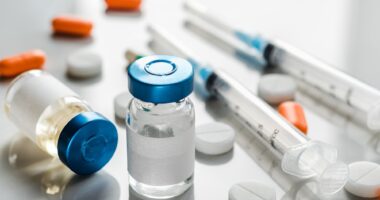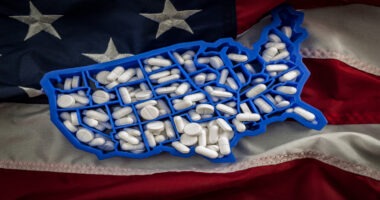J&J: What May Be Next for Its Pharmaceutical Business?
Johnson & Johnson (J&J) has confirmed that it is in preliminary discussions with Actelion Pharmaceuticals, an Allschwil, Basel, Switzerland-headquartered biopharmaceutical company, regarding a potential transaction. So how would such a deal fit into J&J’s pharmaceutical strategy?
A potential acquisition or equity stake in Actelion would provide J&J drug assets in rare diseases, an area that J&J has leveraged to its advantage with other key deals such as its partnership with Pharmacyclics, which AbbVie subsequently acquired. So what are the top performers and pipeline contenders for J&J in its pharmaceuticals business and what generic-drug competition may loom?
A possible deal in the making
Johnson & Johnson (J&J) confirmed in late November 2016 that is engaged in preliminary discussions with Actelion Pharmaceuticals, an Allschwil, Basel, Switzerland-headquartered biopharmaceutical company, regarding a potential transaction. Acetlion also confirmed that it had been approached by J&J regarding a possible transaction.
In a statement released by J&J on November 25, 2016, the company said that “[t]here can be no assurance any transaction will result from these discussions. Johnson & Johnson does not intend to make any additional comments regarding these discussions unless and until it is appropriate to do so, or a formal agreement has been reached.”
Actelion is focused on the field of pulmonary arterial hypertension (PAH), a chronic, disorder characterized by abnormally high blood pressure in the arteries between the heart and lungs. It also several drugs to treating specialist diseases, including Type 1 Gaucher disease, Niemann-Pick type C disease, digital ulcers in patients suffering from systemic sclerosis, and mycosis fungoides in patients with cutaneous T-cell lymphoma. The company was founded in 1997 and has more than 2,400 employees covering key markets around the world, including in Europe, the US, Japan, China, Russia, and Mexico.
Actelion’s PAH franchise leads the company’s product sales. Actelion’s PAH franchise encompasses oral, inhaled and intravenous formulations of compounds, for patients at various stages of the disease. For the first nine months of 2016, Acetlion’s product sales rose to CHF 1.785 billion ($1.75 billion), a 14% increase, year over year, at constant exchange rates (CER). In 2015, the company’s product sales crossed the $2 billion mark for the first time with sales of CHF 2.042 billion ($2.006 billion). Its top-selling product is Tracleer (bosentan), an orally available endothelin receptor antagonist for treating PAH, which posted 2015 sales of CHF 1.212 billion ($1.191 billion), an 18% decrease in Swiss francs and a 15% decrease at CER, as it faces generic competition. Its next-generation PAH drug is Opsumit (macitentan), introduced in 2013, with 2015 sales of CHF 516 million ($507 million). Other drugs in its PAH franchise are: Uptravi (selexipag); Veletri (epoprostenol for injection); and Ventavis (iloprost). Uptravi was introduced in the US in January 2016 Uptravi, originally and was discovered and synthesized by Nippon Shinyaku. It is an oral, selective IP receptor agonist targeting the prostacyclin pathway in PAH. Veletri is an intravenous prostacyclin and is stable at room temperature, removing the need for patients to carry ice packs and posted 2015 sales of CHF 83 million ($82 million). Ventavis is an inhaled formulation of iloprost, a synthetic compound structurally similar to prostacyclin (PGI2) and marked by Actelion in the US and by Bayer elsewhere. Acetelion posted 2015 sales for the drug of CHF 105 million ($103 million).
J&J’s pharmaceutical business
For J&J, an acquisition or stake in Actelion would add a rare-disease focus to the company’s pharmaceutical business, which posted 2015 sales of $31.4 billion. J&J is focused on five therapeutic areas: immunology (e.g., rheumatoid arthritis, inflammatory bowel disease, and psoriasis); infectious diseases and vaccines (e.g., HIV, hepatitis, respiratory infections, and tuberculosis), neuroscience (e.g., Alzheimer’s disease, mood disorders, and schizophrenia), oncology (e.g., prostate cancer, hematologic malignancies, and lung cancer), and cardiovascular and metabolic diseases (e.g., thrombosis and diabetes).
Immunology is the company’s largest therapeutic franchise with 2015 sales of $10.4 billion, and it is in this franchise that it faces generic competition for its top-selling product,Remicade (infliximab), an anti-inflammatory drug. Remicade posted 2015 sales of $6.56 billion and is facing biosimilar competition in certain markets outside the US and pending competition in the US. Other key drugs in its immunology franchise are: Stelara (ustekinumab), drug to treat plaque psoriasis, psoriatic arthritis and Crohn’s disease, with 2015 sales of $2.4 billion and Simponi/Simponi Aria (golimumab), a drug to treat rheumatoid arthritis, psoriatic arthritis, ankylosing spondylitis, and ulcerative colitis, with 2015 sales of $1.3 billion.
The company’s next largest franchise is cardiovascular , which posted sales in 2015 of $6.4 billion, followed by neuroscience with total product sales of nearly $6.3 billion. Oncology products tallied sales of nearly $4.7 billion in 2015, and infectious disease products sales in 2015 were $3.7 billion. Within these franchises, the company has several blockbuster drugs (sales in excess of $1 billion). In its cardiovascular franchise, key performers are: Xarelto (rivaroxaban), a blood thinner, with 2015 sales of nearly $1.9 billion; Invokana/Invokamet (canagliflozin), a drug to treat Type II diabetes, with 2015 sales of $1.3 billion; and Procrit/Eprex (epoetin alfa), a drug to treat chemotherapy-induced anemia or anemia from chronic kidney disease, with sales of nearly $1.1 billion. The top drug in the company’s neuroscience franchise is Invega Sustenna/Xeplion/Invega Trinza (paliperidone palmitate), an antipsychotic, with sales of $1.8 billion. In oncology, key drugs are: Velcade (bortezomib), a drug to treat multiple myeloma with 2015 sales of $1.3 billion, and Zytiga (abiraterone), a hormone-based chemotherapy, with sales of $2.2 billion. In infectious disease, the key performer is Prezista/Prezcobix/Rexolasta (darunavir/cobicistat), an HIV treatment, which posted sales of $1.8 billion in 2015.





